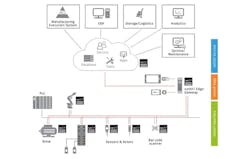While meeting with Armin Pühringer, business development manager at Hilscher, during Hannover Messe 2015, we spoke at length about the impact Industry 4.0 and the Internet of Things are having on the industrial market and the companies that supply them. (You can read my report on that meeting here.) During that meeting, Pühringer hinted at some significant developments that would be forthcoming from Hilscher on this front — and that information is now ready for release.
Like many industrial technology suppliers these days, Hilscher is adapting its business strategy to address the Industrial Internet of Things (IIoT). Its first formal announcements around this trend include the company’s participation in the IBM Bluemix Partnership program and the release of its netIOT Industrial Cloud Communications portfolio of products and services.
As a long-time provider of industrial field device communication and network products dating back to 1986, Hilscher finds itself in an IIoT sweet spot through its concentration on device communication chips for automation suppliers and gateways for industrial end users. More precisely, Hilscher’s focus on enabling industrial communication in a distributed format, i.e., not loading PLCs with the data for use on the network, fits well within the IIoT concept of gathering data directly from disparate devices for analysis in the cloud.
“The data is on the wire,” says Phil Marshall, CEO of Hilscher North America. “By handling data delivery via fieldbus, and supporting 17 different networks on a common format, we don't have to load down the PLC with IIoT functions. This also helps create a barrier to the PLC to protect it from cyber intrusions that could impact operations.”
Pühringer noted during our Hannover Messe meeting that the exciting thing about IIoT for many manufacturers is that the starting point is based on existing plant infrastructure—the field network that is already in place and on which Hilscher focuses.
Guided by the Industrial Internet Consortium, Industry 4.0’s reference architecture, and leveraging associated IT and OT communication standards such as OPC UA, MQTT, and DDS, Hilscher’s netIOT Industrial Cloud Communication technology and service offering is designed to “facilitate data exchange between the components of an automation network and the cloud or IIoT-directed applications,” says Pühringer. “It opens the door for cloud-based enterprise communications down to the field level.”
The netIOT family encompasses three segments:
- netIOT Interface Modules: For embedding IoT connectivity in low-level devices such as sensors and enabling the direct connection of sensor data to the cloud. Pühringer notes an important facet of the netIOT Interface is its ability to provide a virtual representation—or digital twin—of a device for IoT applications. The ability for outside systems to interact with the virtual version of a device via a network connection, rather than directly, is a key aspect of device and system security, but also allows for the cyclic process of testing and proving that is integral to IIoT applications.
- netIOT Edge-Gateways: Three gateway products—Connect (for end users), Remote (for OEMs) and On-Premise (for system integrators)—enable the collection of data from devices connected to industrial Ethernet networks for distribution to the cloud. Interoperability protocols such as MQTT and OPC UA are embedded in all three, enabling communication with IIoT-ready field devices. Essentially, these gateways enable wireless connectivity in various industrial devices so that smart mobile technologies, such as tablets and phones, can be used to access those devices for configuration and diagnostics. Security aspects are handled via Intel’s Moon Island technology. Pühringer adds, “Our netIOT Edge-Gateways connect field data with Bluemix platforms and applications supplied as a service by IBM. Customers can buy these services on an as-needed basis” for the IIoT projects they are working on.
- netIOT Service: This offering includes a range of options that provide end users with ways to launch IIoT projects and gain experience, such as with netIOT Studio, which supports device data selection and IIoT configuration. Pühringer also notes that additional “modules covering diagnostics and predictive maintenance are being developed and a series of partnerships with major cloud-based suppliers is being established” to add to the netIOT Service offering.
Beyond gateway configurability, Hilscher’s netIOT Studio and Node-RED software are pivotal in connecting the Edge-Gateways to the netIOT Service offerings. Node-RED is a web-based IIoT connection editor used to build a graphical user interface for modeling the data flow from device to the cloud or other repository for analysis. Pühringer says that applications in Node-RED can be easily created through the use of Node-RED’s pre-programmed nodes as function blocks. The netIOT Studio software is designed for simplified network configuration, allowing for use of required drivers, fieldbus configurations, and OPC UA, MQTT or DDS protocols.
Pühringer says that Hilscher is currently working with IBM on a pilot installation in Germany to prove out application of netIOT Industrial Cloud Communication technology with IBM’s BlueMix applications. Results of this project will be made public at Hannover Messe 2016 in April.
Companies in this Article
Leaders relevant to this article:


